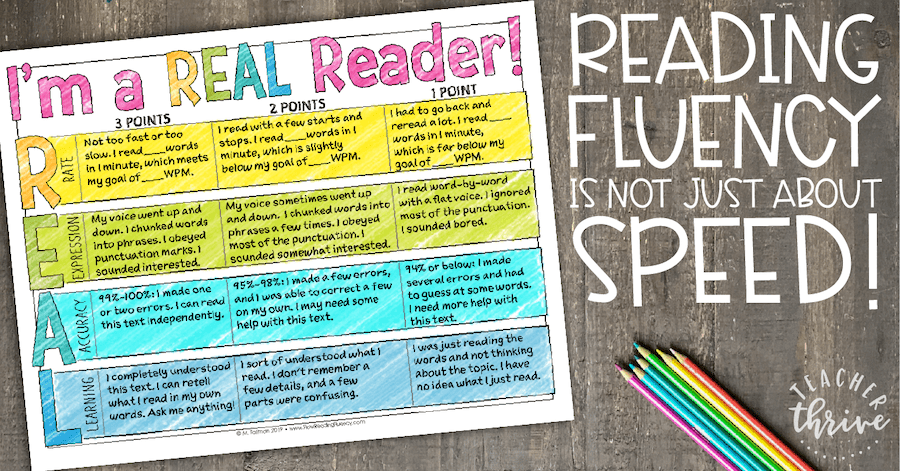
Over the last several years, reading fluency has become synonymous with speed. This connection between fluency and speed is likely an unintended consequence of one-minute readings, which gained popularity in the early 2000s. When we only focus on reading speed, students become “word callers” or “word barkers.” Obviously, is NOT the goal of reading fluency instruction. The ultimate goal of improving reading fluency is to improve reading comprehension, and studies have proven that fluent readers are over 90% more likely to comprehend text. However, overly focusing on speed is not the answer.
Don’t throw out your timers or stopwatches just yet! One-minute readings are a sound educational practice. They became popular because they work, and they should continue to be used. However, timed readings are just one piece of a comprehensive fluency program.
In this post, I am going to…
- present the traditional definition of reading fluency.
- discuss a more comprehensive definition of reading fluency.
- share a way you can actively involve your students in improving their reading fluency.
The Traditional Definition of Reading Fluency
The traditional definition of reading fluency is the ability to accurately read text at an appropriate rate and with prosody. This definition emphasizes three main components: accuracy, rate, and prosody.
Over the years, the focus on accuracy and rate usurped prosody, and reading fluency became synonymous with speed. Reading fluency is not just about speed! In fact, it’s not just about the three components listed above (accuracy, rate, and prosody). There is one more essential element needed to define reading fluency—comprehension.
A Comprehensive Definition of Reading Fluency

For our purposes, we will define reading fluency by incorporating all four of the components: accuracy, rate, prosody, and comprehension.
While these four pillars of fluency do not function in isolation, it is important to understand each of them individually.
Accuracy
For students to comprehend what they read, they must accurately identify most of the words in a text. Comprehension is greatly affected when critical words or a large percent of words are misread.
Accurately decoding words requires reader to (a) identify sounds represented by the letters or letter combinations, (b) blend phonemes, (c) read phonograms (letter patterns within words; e.g. /oi/ in boy), and (d) use both letter-sound and meaning cues to determine the pronunciation and meaning of the word used in the text (e.g., The dove flew over our heads. We dove into the swimming pool.).
Rate
Rate includes two factors: automaticity and speed. Automaticity is quick and effortless word identification, in or out of context. Automaticity is important because readers have limited attention for more complex processes. If readers are laboring through word identification, their capacity to comprehend the text is greatly hindered.
Speed also relates to comprehension. It is common for students who read slowly to fail to complete their word, lose interest in school, and rarely read for pleasure.
However, it is important to note that reading rate does not ensure comprehension. We have all had students who read fast, yet they do not understand what they read.
Prosody
Prosody (sometimes referred to as expression) is the rhythmic and tonal aspects of speech. It refers to a reader’s ability to read smoothly with appropriate phrasing and expression. Prosody includes variations in pitch (intonation), stress patterns (syllable prominence, and duration (length of time). Prosody also encompasses phrasing or parsing text into appropriate segments.
Reading with prosody can be especially challenging because prosodic features are not always graphically represented in the text; the reader must use the meaning of the text to identify them. This is especially true in the case of phrasing, which requires readers to pause after a related group of words.
Comprehension
Does the student understand what he just read? Could he provide an accurate retelling or summary of the text?
Over the years, this comprehension has been overlooked in fluency instruction as education has focused on accuracy and rate. However, a comprehensive fluency program must include comprehension instruction. Authentic reading does not occur in one-minute bursts of cold and hot timings. While these timed readings serve an important purpose, we must be careful to communicate to students that understanding the text is the ultimate goal.
Teachers must engage readers beyond how accurately, fast, or expressive they read text.

Involving Students in Reading Fluency Instruction
It’s not only important for teachers to have a comprehensive understanding of reading fluency—students should also thoroughly understand it! You can download this free REAL Readers rubric for students. Enter your email address to receive this rubric via email.
R = Rate (speed), E = Expression (prosody), A = Accuracy, and L = Learning (comprehension)
This simple rubric serves a few different purposes:
- It communicates to students that fluency is so much more than just speed.
- It actively involves students in the process of improving their reading fluency.
- It helps students to become self-reflective readers.
Students should aim for an overall score of 9 or higher.










